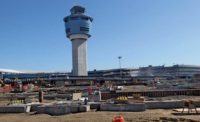With recession-stricken states stripping road and bridge projects from their improvement agendas and no federal surface transportation reauthorization bill on the horizon, transportation design firms are trying to make the most of a sluggish market.

Little of the $40 billion allocated to transportation under the American Recovery and Reinvestment Act (ARRA) has found its way to design firms, as states stayed true to the “shovel-ready” theme and applied the bulk of the funds to routine maintenance, paving and design-build projects in order to meet the program’s accelerated obligation schedule.
“The stimulus was only marginally helpful to designers,” says George Pierson, CEO of Parsons Brinckerhoff, New York City. “Otherwise, it remains a tight and difficult market.”
That doesn’t mean the market is bereft of opportunities, however.
Several larger projects are moving forward, including the $5.5-billion San Francisco-Oakland Bay Bridge Seismic Safety Project, which will include a new 2.1-mile bridge designed by a joint venture of San Francisco-based T.Y. Lin International and Long Beach, Calif.-based Moffatt & Nichol; the replacement of Seattle’s Alaskan Way Viaduct with a $2-billion tunnel, which is being administered by Parsons Brinckerhoff; and the $1.1-billion reconstruction of 23 miles of I-15 between American Fork and Provo, Utah, by the design-build team of Irving, Texas-based Fluor Corp. and Omaha, Neb.-based HDR Inc.
The sector receiving the most buzz in recent months is high-speed passenger rail, thanks in part to the initial $8-billion, ARRA-funded outlay for the National High Speed Intercity Passenger Rail (HSIPR) program. But while transportation designers welcome the federal government’s renewed emphasis on rail and the potential range of opportunities, many are wary that the initiative could lose its momentum.
Eric Keen, HDR’s national transportation director, says that, because of high-speed rail’s inherent cost and technical challenges, “a long-term federal commitment to the program is needed, along with the recognition that it will take years to implement.”
The $2.6-billion Tampa-Orlando segment in Florida and California’s 800-mile, $45-billion system received the largest shares of HSIPR funds, and they are considered furthest along in development.
“The big question is where will the rest of the funding come from for these and other projects—the private sector, the federal government, states or all of them,” says T.Y. Lin President and CEO Alvaro Piedrahita, whose firm is providing program management oversight to the California High Speed Rail Authority.
Momentum
Richard M. Amodei, senior vice president of Douglassville, Pa.-based STV Inc., believes high-speed rail will gain momentum as states better understand how to integrate the systems into their transportation mix. STV is providing environmental and engineering services for California’s Los Angeles Union Station-to-Orange County segment and assisting the Federal Railroad Administration with program management oversight.
High-speed rail’s popularity has had a ripple effect on transit projects, which have not lost their efficient, environmentally friendly luster despite the moderation in gas prices.
“This is one of the sweet spots in the industry, especially with the growing emphasis on livable communities,” says Keen, whose firm conducted the major investment study for Tucson’s proposed $144-million, 3.9-mile, modern streetcar program.
Foremost on everyone’s minds is the overdue successor to the Safe, Accountable, Flexible, Efficient Transportation Equity Act, the funding formulas of which have been extended through the end of this year. The already contentious issue of where the program’s revenue will come from—gas taxes, vehicle miles traveled or another method—has been further complicated by the slow economic recovery, deficit worries and stalled legislation on climate change.
Industry sources believe it will be after the November elections, at the earliest, before Congress will take up the issue.
| Rank* | Firm | $ Mil. |
|---|---|---|
| 1 | AECOM Technology Corp. | 1,726.5 |
| 2 | URS Corp. | 1,383.0 |
| 3 | Parsons Brinckerhoff Inc. | 901.2 |
| 4 | Louis Berger Group | 808.7 |
| 5 | Jacobs | 775.9 |
| 6 | HNTB Cos. | 720.9 |
| 7 | CH2M HILL | 560.1 |
| 8 | HDR | 543.6 |
| 9 | Parsons | 512.5 |
| 10 | STV Group Inc. | 251.6 |
| 11 | The PBSJ Corp. | 222.0 |
| 12 | Kimley-Horn and Associates Inc. | 210.9 |
| 13 | TranSystems Corp. | 205.0 |
| 14 | Michael Baker Corp. | 186.7 |
| 15 | Wilbur Smith Associates Inc. | 172.9 |
| 16 | Gannett Fleming | 167.4 |
| 17 | T.Y. Lin International | 162.6 |
| 18 | Hatch Mott MacDonald | 127.9 |
| 19 | AMEC | 122.0 |
| 20 | Bechtel | 121.0 |
| 21 | Stantec Inc. | 120.4 |
| 22 | Moffatt & Nichol | 117.4 |
| 23 | Reynolds Smith and Hills Inc. | 115.0 |
| 24 | Stanley Consultants Inc. | 110.9 |
| 25 | Dewberry | 108.1 |
| *Based on 2009 contracting revenue from transportation as reported in enr’s survey of leading contractors and design firms. | ||




Post a comment to this article
Report Abusive Comment